Recent Articles
Popular Makes
Body Types
2017 Porsche 911 Road Test and Review
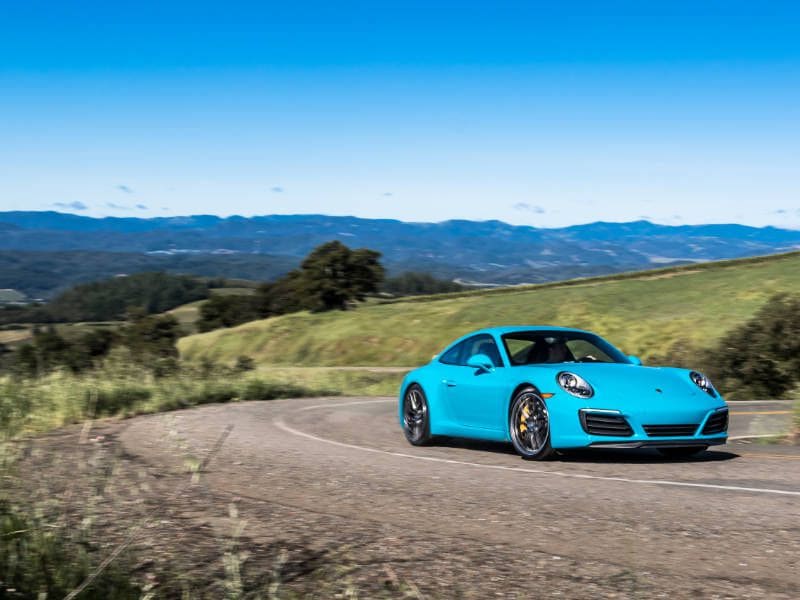
2017 Porsche 911 Carerra Action ・ Photo by Porsche
If you want to live, drive a 2017 Porsche 911 across America.
Any excuse will do. Visit Grandma in Des Moines. Suck down some BBQ in KC. Take in Mt. Rushmore. Buy beer in Texarkana. It doesn’t matter. Just do it. And do it in a Porsche 911.
The moment of clarity will come in the golden glow of dusk somewhere secluded, just west of Salt Lake City, perhaps, in the wide open expanse of the west with backlit views of purple mountains and their majesty. You’ll click it down a few gears and enjoy the upper RPM pull of the Porsche’s new turbocharged engine. Your heart rate will jump along with its tach needle as the speed climbs well past the legal limit and soon, sanity.
You’ll do it again and again and again, and then you’ll flick on the seat heater and dial in some jazz on the Bluetooth audio.
And that’s when you’ll realize just how special the 911 is. A car with this much performance used to be called a race car. A car with this much comfort was once called a luxury car. Today it’s called the 2017 Porsche 911. And it’s one of the greatest sports cars to ever roam the earth.
Models and Pricing
The 2017 Porsche 911 comes in three body styles: Coupe, Cabriolet and Targa. The Cabriolet, which features a folding soft top, and Coupe are available as the 370-hp Carrera and all-wheel drive Carrera 4 and the 420-hp Carrera S and all-wheel drive Carrera 4S. With its unique retracting roof panel, the Targa is available as the 420-hp Targa 4 and Targa 4S, both with all-wheel drive.
The top-of-the-line 911 Turbo models are also all-wheel drive only and available in three flavors: the 540-hp Turbo Cabriolet and the 580-hp Turbo S Coupe or Cabriolet.
This year, for the first time, every 911 is powered by a turbocharged flat 6-cylinder engine backed by a 6-speed manual transmission. A 7-speed automatic transmission is optional. It’s also the only transmission offered in the Turbo models.
The standard 911 Carrera, like our test vehicle, costs $92,150, including a $1,050 destination and handling fee. With a few options, including the PDK automatic transmission, the price of our 911 test vehicle jumped to over $98,000.
If you want more performance, step up the Carrera S for $106,150. It’s stacked with an additional 50 hp and other upgrades such as 20-inch wheels. Cabriolet models add about $13,000 to the price. All-wheel drive models start at $99,050 for the Carrera 4 Coupe.
Targa models start at $111,350 and the 911 Turbo Cabriolet carries a base price of $175,150. A 911 Turbo S Cabriolet is up over $200,000.
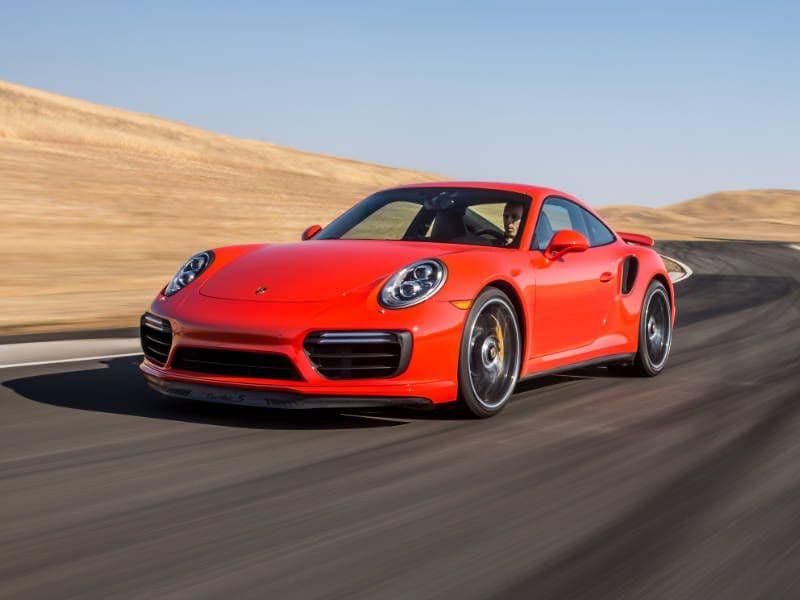
Photo by Porsche
Turbocharged Power
Unlike every other car and truck on the market, the Porsche 911’s engine is in the back. The way back. This is a rear-engine car. And it’s the last of its kind.
The engine itself is a smooth, powerful and sophisticated all-aluminum double overhead cam twin-turbocharged 3.0-liter flat 6-cylinder that replaces the normally aspirated flat 6-cylinder that has powered the 911 since dinosaurs roamed the earth. Some purists have squawked at the change, but this new engine makes more low-end torque, it’s more fuel efficient, and Porsche has made it sound just as sweet as the old unboosted six. Redline is 7,250 RPM.
Porsche says the standard Carrera can run from 0-60 mph in just 4.4 seconds with the 6-speed manual transmission. The automatic is two-tenths of a second quicker. Top speed is 183 mph. The more powerful Carrera S hits 60 mph in 3.9 seconds with the automatic and has a top speed of 191 mph.
The big dog 911 Turbo S is one of the quickest and fastest cars on the planet, hitting 60 mph in 2.8 seconds, and its top speed is 205 mph.
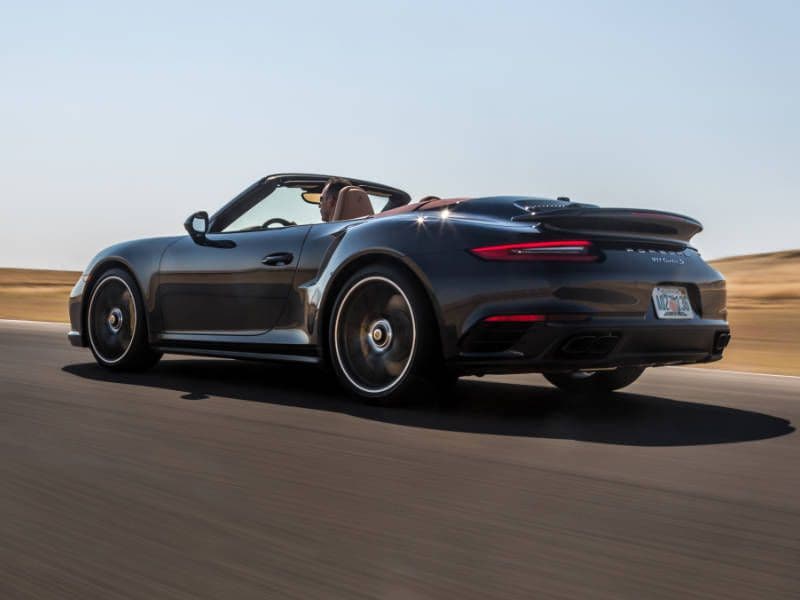
Photo by Porsche
Curb Appeal
Somehow the new 911 is exciting, elegant, casual, sophisticated, understated, classic, and contemporary all at the same time. And it’s striking from every angle. This car is always in style. And it always will be. It’s a timeless creation, like an ice-cold beer or a woman’s little black dress. It doesn’t seem to age.
Porsche’s design philosophy is to evolve what already works, and the new 911 looks a lot like the old one and the one before that and the one before that and the one before that. This is a good thing. Although today’s 911 is much longer and wider than the original from 1965, the family resemblance is unmistakable 52 years later. And it still looks like nothing else on the road. Everyone knows this is a Porsche 911, and they look at it when you drive by.
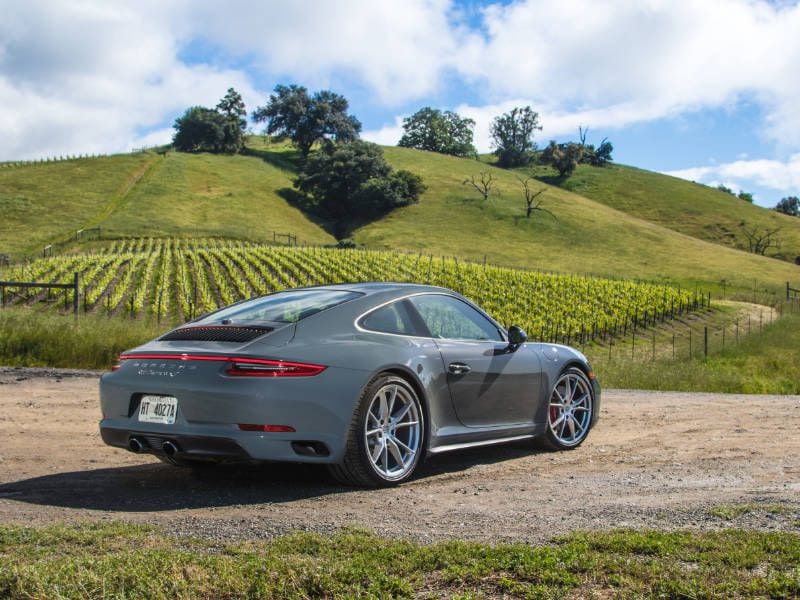
Photo by Porsche
Interior Pros and Cons
Inside the 911, build quality is extremely high, everything is assembled with precision, and the materials used feel right at the Porsche’s big price. There’s also a surprising amount of room up front, considering the car's slight dimensions. The rear seat is usable for two kids, even pre-teens or one adult with short legs. The seats also fold to increase cargo capacity.
Seat comfort in our softly-optioned Carrera coupe test vehicle was exceptional and its seat heaters were properly cozy. Porsche put the 911’s shifter is right where you want it, and its thick, leather wrapped steering wheel is faultless. The 7-inch touch screen is large enough and its functions are intuitive to use. Visibility is excellent.
With a very shallow console bin and tiny door pockets, however, interior storage is seriously limited. There’s really no place to conveniently throw your wallet and cell phone.
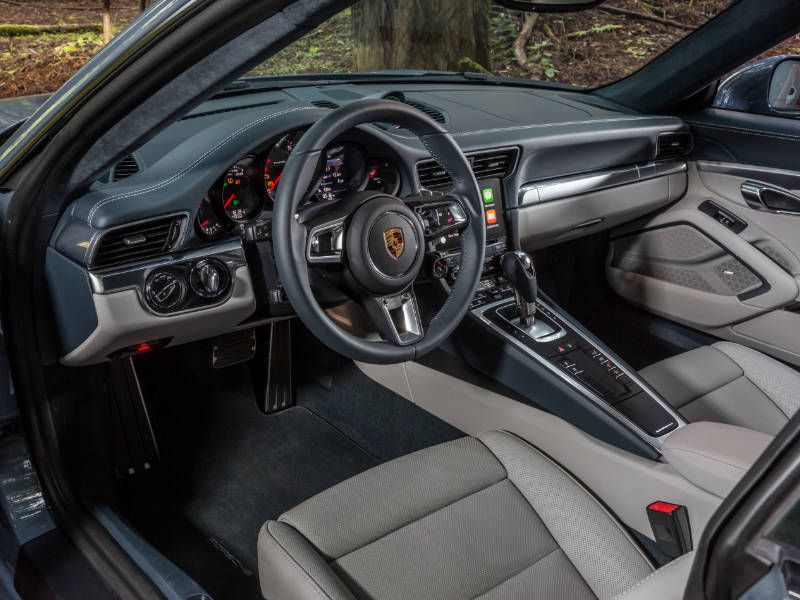
Photo by Porsche
How it Drives
Low end power is more than sufficient, even in the base Carrera model. Then the turbo boost comes on strong around 3,000 rpm. Max out the tachometer in a few gears and you’ll get the adrenaline rush you’re looking for, along with the attention of a few police officers.
It’s an easy car to drive. It feels like a sports car, but it never beats you up or feels crude. This is a refined machine with a compliant ride and a very comfortable interior. Its steering and clutch efforts are light and livable, day in and day out.
It does everything well. It’s at home in the race to get home and it’s ready for the racetrack. Drive it hard and it really comes alive. The turbocharged engine sounds right and it likes to rev. The transmission is geared perfectly.
If you want to scream with pleasure, drive a 911 down a twisty 2-lane. This is one of the best-handling cars available, with seemingly endless grip on the road and brakes that can stop time.
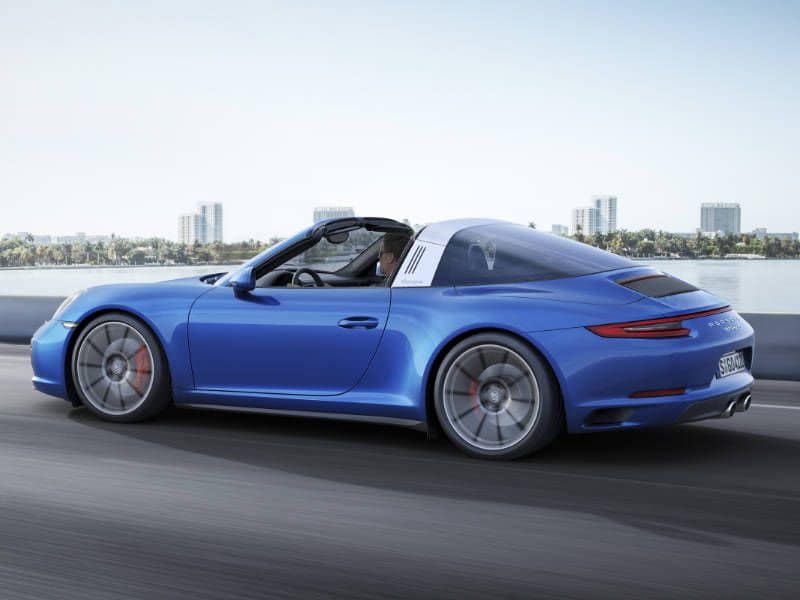
Photo by Porsche
Cargo and Cupholders
Because of its unique rear-engine layout and clever packaging, the 2017 911 actually has its trunk in the front. The frunk (front trunk), as it’s called by 911 devotees, is deep and offers 4.76 cubic feet of space. It’s not much, but if you pack properly and maximize the space, it’s just enough for a weeklong road trip for two, especially if you’re willing to utilize the back seat for spillover. It also makes the 911 surprisingly supermarket friendly.
The 911’s two cupholders, however, are wanting. They ingeniously deploy from inside the dashboard to save space, but they don’t handle large drinks very well. And they place the beverage precariously above the car’s console. Throw the 911 into a corner and your kale smoothie will be all over everything.
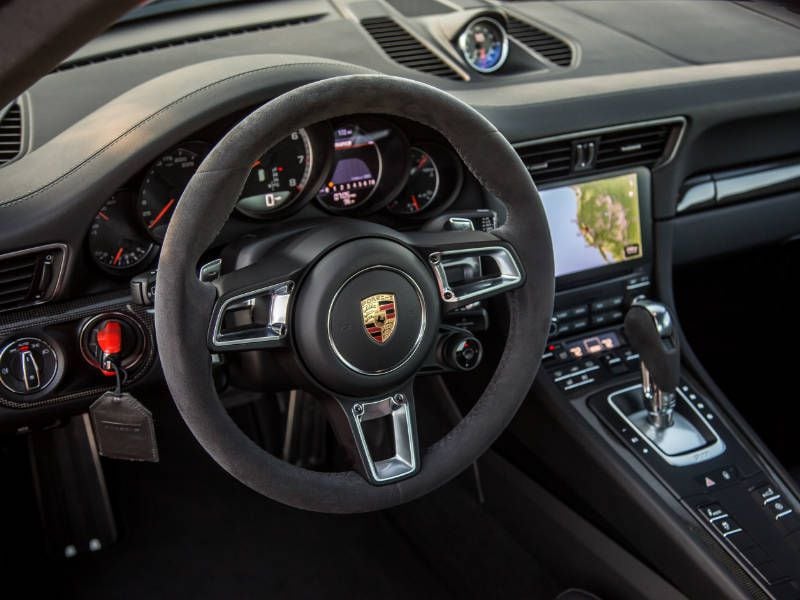
Photo by Porsche
Surprising Fuel Economy
The 911 is surprisingly fuel-efficient considering its high horsepower, and its economy numbers are strong for its class.
With the s6-speed manual, the 370-hp 911 Carrera is rated by the EPA at 20 mpg city and 29 mpg highway. With the available automatic, those numbers increase slightly to 22 mpg city and 30 mpg on the highway. In mixed driving, we averaged 23 mpg in our 911 Carrera test vehicle with the PDK automatic.
The more powerful 911 Carrera S and all-wheel drive equipped Carrera 4 and 4S achieve 20 mpg city and 28 mpg on the highway with the manual and 22 mpg city and 28 mpg on the highway with the automatic. Turbo S models are rated 19 mpg city and 24 mpg highway.
All models require premium fuel.
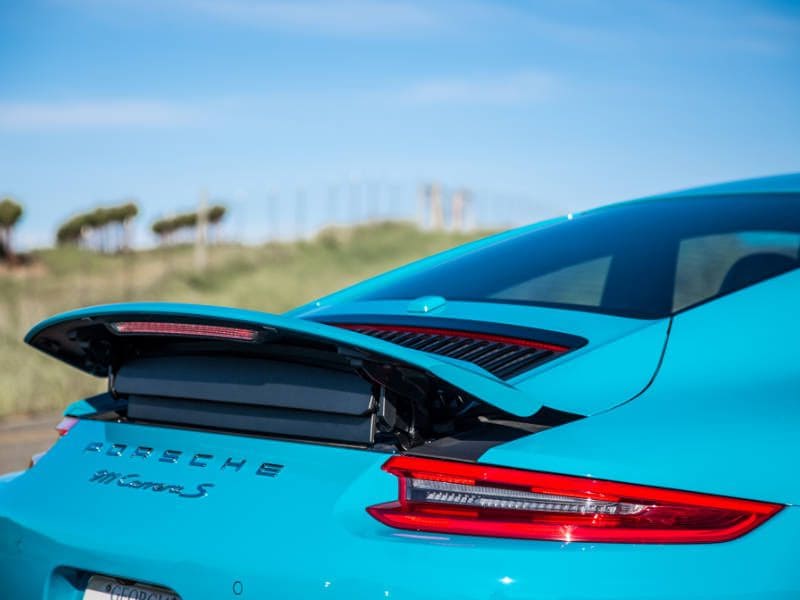
Photo by Porsche
The Stiff Competition
Some of the 911’s competition is home grown and comes in the form of Porsche’s own 718 Cayman and 718 Boxster convertible. They’re without the 911’s small back seat, available all-wheel drive, or cachet, but they’re just as fun to drive and they cost tens of thousands less. Prices for the 718 Boxster with 300 hp start at about $50,000.
Jaguar’s 2-seat F-type is also worth checking out. It’s also available with all-wheel drive. And the 4-seat BMW M6 packs 560 hp. The Nissan GT-R is a different beast but a worthy rival. And then there’s the Chevrolet Corvette, which offers significantly more power and cargo space than the 911 for far less money.
The list of competitors for the 911 Turbo includes the mid-engine Audi R8, the hybrid-powered Acura NSX, and assorted Ferraris and Lamborghinis.

Photo by Porsche
Final Thoughts
The Porsche 911 is something special. It’s fast, refined, and packed with personality. It’s also comfortable enough to be driven every day.
Although the standard 370 hp Carrera is more than enough for most buyers, we recommend stepping up to the Carrera S model if you can. Over time, you’ll appreciate the additional power and features. Personally, I’m in love with the hardened look of the Targa 4S.
For those in the market for a sexy high-performance coupe or convertible, the 2017 Porsche 911 is a very desirable choice. It’s simply one of the best cars in the world.
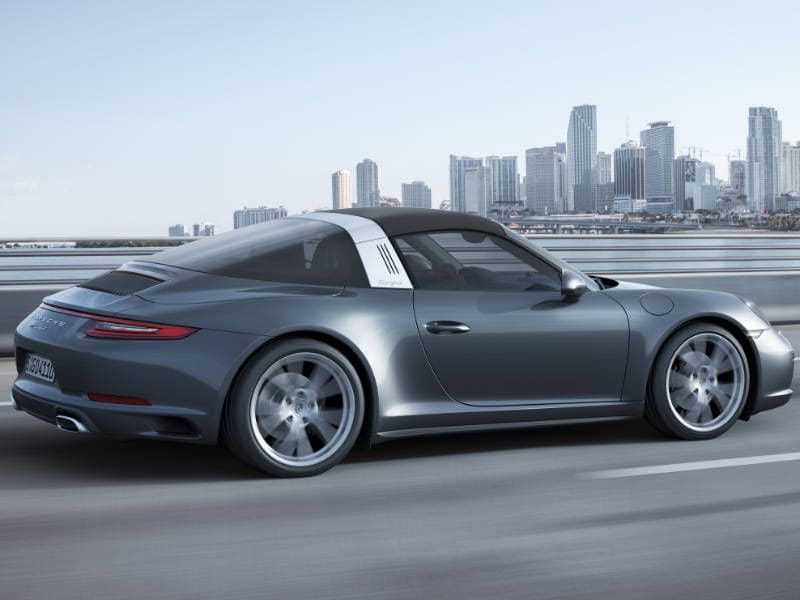
Photo by Porsche